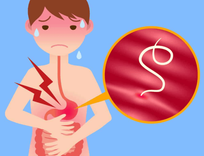1. Why do newborns vomit yellow fluid? Newborns may vomit yellow fluid for several reasons:
1.1 Functional vomiting
- The baby is being held in the wrong position while breastfeeding;
- The baby is overfed and is laid down immediately after feeding;
- The baby is being wrapped too tightly, putting pressure on the stomach;
- The mother sticks her finger too deep into the baby's mouth during tongue cleaning, causing the baby to vomit.
These are common causes of vomiting mucus or yellow fluid.
1.2 Pathological vomiting
Frequent vomiting of yellow, mucous fluid may indicate that the baby has certain medical conditions such as:
- Digestive disorders: Diarrhea, slowed bowel movements, intestinal obstruction, intussusception, congenital gastrointestinal malformations, acid reflux, etc.;
- Respiratory diseases;
- Other conditions: Pyogenic meningitis, autonomic nervous system disorders, brain hemorrhage due to depletion of Prothrombin, adreno-genital syndrome, etc. These are less common causes, the diagnosis usually is delayed, but they can lead to serious complications for the child if not detected and treated promptly.

2. Why do young children vomit yellow fluid?
The symptoms of vomiting yellow fluid with varying shades may also indicate health issues such as:
2.1. Causes of yellow and greenish vomit fluid
If a child vomits yellow or greenish fluid, it could be due to bile fluid. However, parents should not worry too much, as sometimes the reason is simply that the child’s stomach is empty or they have viral gastroenteritis (viral inflammation of the stomach and intestines).
Additionally, vomiting yellow and greenish fluid can be intestinal hernia or galestones, causing bile obstruction, usually accompanied by symptoms such as loss of appetite, constipation, abdominal cramps, etc. However, gallstones are quite rare in young children.
2.2 Causes of orange vomit fluid
Parents may notice their child vomiting orange fluid a few hours after experiencing certain illnesses. This condition may persist if parents continue to feed the child between bouts of vomiting (as orange is the color of digested food). The reasons for young children vomiting orange fluid include:
- Food poisoning: After consuming contaminated food, a child may vomit along with other symptoms such as abdominal pain, diarrhea, fever, etc.;
- Viral gastroenteritis: A child may exhibit symptoms of vomiting orange mucous fluid accompanied by other symptoms like mild fever, muscle aches, and abdominal pain;
- Flu: Symptoms include runny nose, sore throat, prolonged high fever, fatigue, headache, chills, and vomiting orange fluid. 2.3 Other causes
Additionally, children may vomit yellow fluid due to appendicitis, intussusception, motion sickness, chemotherapy, ear infections, or using certain specific medications, etc.
3. What to do when a child vomits yellow fluid?
When a child shows signs of vomiting yellow fluid, parents should immediately take the following actions:
- Turn the child's head to one side to prevent choking on vomit. Then, use gauze to clean the vomit from the child's mouth, throat, and nose;
- Cup your hands and gently pat the child on the back to comfort them and help them vomit the remaining contents;
- Use a warm cloth to wipe the child's face and neck, and change their clothes if they are soiled with vomit;
- Once the child calms down, give them warm water or warm oral rehydration solution;
- Gradually offer breast milk again and soothe the child to sleep;
- Do not arbitrarily give the child anti-nausea medication. If the child vomits yellow fluid due to choking or has a foreign object in their throat, act quickly by positioning the child face down and gently patting their back. If there is milk coming out of the child's nose and throat, it should be suctioned out. Then, use two fingers to push down hard on the central breastbone of the child five times and take them to the hospital for timely examination.

4. Is vomiting yellow fluid dangerous?
Vomiting itself is not a disease but a symptom of various medical conditions such as infections or other chronic illnesses. Generally, the color of vomit will change according to different stages of illness or particular medical conditions. For example, vomiting due to stomach pain may start as green or yellow and later change to orange. If a child vomits for 1-2 days, it usually is not a serious issue. This may simply be the child's body's response to intestinal irritation or an attempt to expel toxic substances.
However, if the child vomits continuously, lasting for more than a few weeks or up to a few months, it may be a symptom of a chronic disease. Parents should take their child to the doctor immediately if the child vomits yellow fluid accompanied by the following symptoms:
- The child is fussy, has a bulging fontanel, convulsions or panic;
- The child vomits continuously for 24 hours;
- The child has abnormal signs of the digestive tract such as bloating, abdominal distension, constipation, diarrhea, etc.;
- The child has signs of dehydration such as dry skin, sunken eyes, dry lips, hair loss, etc.;
- The child's skin color changes, abnormally rapid breathing, and apnea;
- The child has a fever, is lethargic;
- Vomit fluid includes blood or is greenish
The child vomits yellow fluid which may be due to common illnesses, but sometimes it can also be a warning sign of many dangerous conditions. Therefore, when the child vomits with other symptoms, parents should take the child to the doctor immediately for an accurate diagnosis.
To arrange an appointment, please call HOTLINE or make your reservation directly HERE. You may also download the MyVinmec app to schedule appointments faster and manage your reservations more conveniently.













